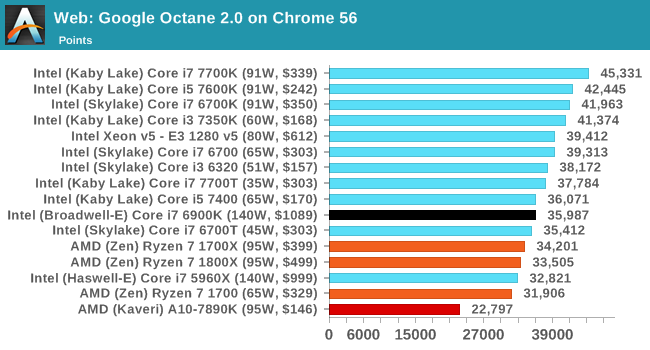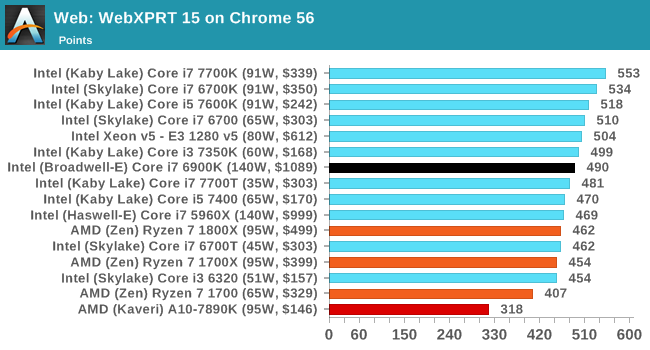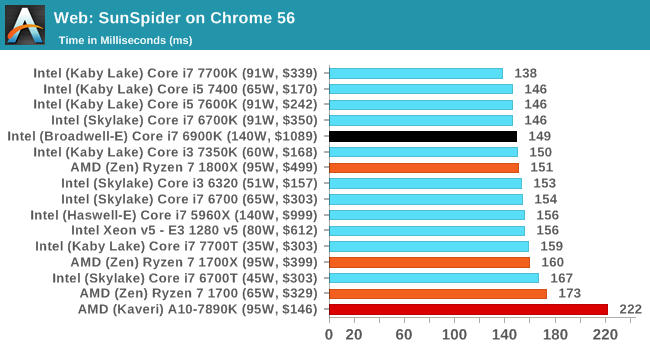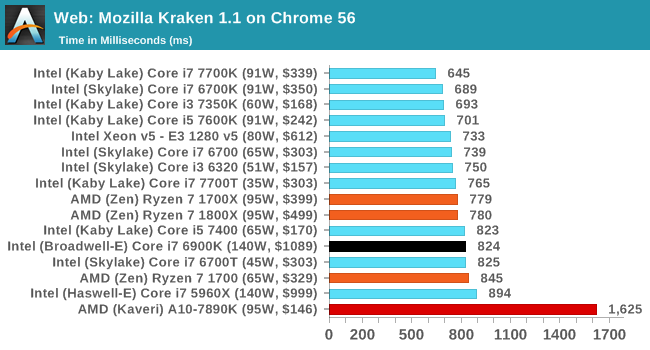The AMD Zen and Ryzen 7 Review: A Deep Dive on 1800X, 1700X and 1700
by Ian Cutress on March 2, 2017 9:00 AM ESTBenchmarking Performance: CPU Web Tests
One of the issues when running web-based tests is the nature of modern browsers to automatically install updates. This means any sustained period of benchmarking will invariably fall foul of the 'it's updated beyond the state of comparison' rule, especially when browsers will update if you give them half a second to think about it. Despite this, we were able to find a series of commands to create an un-updatable version of Chrome 56 for our 2017 test suite. While this means we might not be on the bleeding edge of the latest browser, it makes the scores between CPUs comparable.
SunSpider 1.0.2 [link]
The oldest web-based benchmark in this portion of our test is SunSpider. This is a very basic javascript algorithm tool, and ends up being more a measure of IPC and latency than anything else, with most high performance CPUs scoring around about the same. The basic test is looped 10 times and the average taken. We run the basic test 4 times.
Mozilla Kraken 1.1 [link]
Kraken is another Javascript based benchmark, using the same test harness as SunSpider, but focusing on more stringent real-world use cases and libraries, such as audio processing and image filters. Again, the basic test is looped ten times, and we run the basic test four times.
Google Octane 2.0 [link]
Along with Mozilla, as Google is a major browser developer, having peak JS performance is typically a critical asset when comparing against the other OS developers. In the same way that SunSpider is a very early JS benchmark, and Kraken is a bit newer, Octane aims to be more relevant to real workloads, especially in power constrained devices such as smartphones and tablets.

WebXPRT 2013 and 2015 [link]
While the previous three benchmarks do calculations in the background and represent a score, WebXPRT is designed to be a better interpretation of visual workloads that a professional user might have, such as browser based applications, graphing, image editing, sort/analysis, scientific analysis and financial tools. Web2013 is the older tool, superceded by Web2015, however both still are highly relevant for high-performance web applications today.














574 Comments
View All Comments
Cooe - Sunday, February 28, 2021 - link
Absolute nonsense. Game code is optimized specifically for the Intel Core pipeline & ESPECIALLY it's ring bus interconnect. There's no such thing as "optimizing for x86". Code is either written with the x86 ISA or its not...FriendlyUser - Thursday, March 2, 2017 - link
The 1700X with a premium motherboard is cheaper and faster than the 6850K. If you absolutely need the extra PCIe lanes or the 8 DIMM slots, then x99 is better, otherwise you are getting less perf/$.mapesdhs - Thursday, March 2, 2017 - link
Or a used X79. I'm still rather surprised how close my 3930K/4.8 results are to the tests results shown here (CB10/ST = 7935, CB10/MT = 42389 , CB11.5/MT = 13.80, CB R15 MT = 1241). People are selling used 3930Ks for as little as 80 UKP now, though finding a decent mbd is a bit more tricky.I have an ASUS R5E/6850K setup to test, alongside a used-parts ASYS P9X79-E WS/4960X which cost scarily less than the new X99 setup, it'll be interesting to see how these behave against the KL/BW-E/Ryzen numbers shown here.
Ian.
Aerodrifting - Thursday, March 2, 2017 - link
"$500 1800x is still too expensive. According to this even a 7700k @ $300 -$350 is still a good choice for gamers."Same thing can be said for every Intel extreme platform processors, $1000 5960X/6900K is still too expensive, $1600 6950X is too expensive, Because 7700K is better for gaming.
Then you said "2011-v3 still offers a platform with more PCIe3 lanes and quad memory channel. ", Which directly contradict what you said earlier about gaming, How does more PCIe3 lanes and quad channel memory improve your FPS when video cards run fine with x8.
Your are too idiotic to even run coherent argument.
lmcd - Thursday, March 2, 2017 - link
What on earth are you talking about? PCIe3 lanes and quad channel memory are helpful for prosumer workloads. It's not contradictory at all?mapesdhs - Thursday, March 2, 2017 - link
Yup, quad GPU for After Effects RT3D, and fast RAM makes quite a difference.Notmyusualid - Friday, March 3, 2017 - link
@mapesdhs:Indeed.
Also, I can actually 'feel' the difference going from dual to quad channel ram performance.
I checked, and I hadn't correctly seated one of my four 16GB modules...
Shutdown, reseat, reboot, and it 'felt' faster again.
Aerodrifting - Thursday, March 2, 2017 - link
Learn to read a complete sentence please."nos024" was complaining gaming performance, Then he pulled out extra PCIe3 lanes and quad channel memory to defend X99 platform even though they were also inferior to 7700K in gaming (just like Ryzen). That makes him sound like a completely moron, Because games don't care about those extra PCIe lane or quad channel memory.
Notmyusualid - Friday, March 3, 2017 - link
X99 'inferior'?I just popped over the 3dmark11's results page, selected GPU as 1080, and I had to scroll down to 199th place (a 7700k clocked to a likely LN2 5.8GHz), to find a system that wasn't triple, or quad channel equipped.
Here: http://www.3dmark.com/search#/?url=/proxycon/ajax/...
So I guess those lanes don't help us multip-gpu people after all?
Swallow.
Aerodrifting - Saturday, March 4, 2017 - link
Because 3Dmark11 hall of fame ranking equals real life gaming performance.Are you a moron or just trolling? Everyone knows when it comes to gaming, A high frequency i7 (such as 7700K) beats everything else, Including 8 core Ryzen or 10 core i7 extreme 6950X.